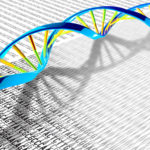Is CRISPR Gene Editing Doomed, Even As Gene Therapy Enters the Clinic?
Anyone watching the recent 60 Minutes segment on CRISPR would conclude that the gene editing technology is on the brink of pouring forth a cascade of cures. But a recent study reveals a mess of missing and moved chromosome parts in the wake of deploying the famed “molecular scissors.”
Invented in 2012, CRISPR brilliantly borrows a bacterial defense against infection. The “clustered regularly interspaced short palindromic repeats” are simple DNA sequences that serve as landing strips in a genome where engineered “guide RNAs” deliver an enzyme to a desired gene, amending or obliterating it. When the enzyme snips across the double helix, natural DNA repair ensues. Cas9 is an oft-used enzyme.
Precision
Unlike conventional gene therapy that adds a gene, sometimes hovering in a DNA loop outside a chromosome, CRISPR swaps in or removes a gene at a precise spot. But it took 27 years for the FDA to approve the first gene therapy, Luxturna, to treat a specific form of hereditary blindness, last December. So CRISPRed drugs won’t be hitting CVS or Walgreen’s shelves anytime soon.
The new report, in Nature Biotechnology, from researchers at the Wellcome Sanger Institute, isn’t the first to find a CRISPR glitch, and it certainly won’t be the last.
In experiments on cells, Allan Bradley, Michael Kosicki and Kärt Tomberg looked beyond CRISPR’s intended landing site, like searching for errors in parts of a book beyond a known typo. They found vast stretches of missing, added, and turned-around text, some even plucked out and plunked down in different chapters, a metaphor for different chromosomal addresses. And although “off-target” effects are well known and small problems with CRISPR have been fixed – safer enzymes, delivery methods, and detection tools – earlier studies may have interrogated the molehills, while missing the mountains.
Rather than using the cancer cells of past studies that can have altered DNA repair and chromosomes, the researchers targeted a well-studied gene in stem cells from mice and human retinal cells “immortalized” to divide. Both are “surrogates for various clinical editing applications.”
Shattered!
Like a plane crashing into a cornfield, CRISPR-Cas9 landing in the cells blew away thousands of DNA bases at a stretch, the largest 9,500 long. The damage reverberated from the target, triggering chromosomal chaos, while single-base mutations (SNPs) popped up too, even beyond the cut sites. Often, more than one thing went wrong. The assaults could kill a cell or send it on a pathway to cancer.
Deletions can expose recessive gene variants that would otherwise be hidden; insertions and translocations alter genetic controls wherever they happen to plop down. Jettisoning a gene to a site next to an oncogene could create a first mutational “hit” that becomes cancer later in life when a second mutation occurs. “In the clinical context of editing many billions of cells, the multitude of different mutations generated makes it likely that one or more edited cells in each protocol would be endowed with an important pathogenic lesion,” the researchers hypothesize.
The experiments had several controls and checks: a different delivery method (electroporation instead of viral vectors); different targeted genes; mouse hybrids with easily-distinguished chromosome sets, like putting white and black socks in a dryer and coming out with patchworks; and repeating interventions four times. “The diversity of potential deletion outcomes is vast,” the researchers conclude.
Repercussions?
Will this unpredictable harpooning of edited genomes slow the trajectory to the clinic, or at least temper the hype? Viewpoints vary.
Steve Gray, a pioneer in gene therapy at the University of North Carolina and the University of Texas Southwestern Medical Center, contrasts the CRISPR sprint to gene therapy’s marathon run. “Clear and significant safety issues are involved that, to my knowledge, haven’t been addressed. The technology is very exciting, but CRISPR could learn from the history of gene therapy about the consequences of moving too fast while a lot of the basic biology and risks are not fully understood.”

Gray has pioneered gene therapies for Batten disease, Rett syndrome, Tay-Sachs disease, Krabbe syndrome, and giant axonal neuropathy, the last in clinical trials. The field of gene therapy halted in the wake of an 18-year-old’s death in one clinical trial in 1999 and leukemia as a side effect in another trial two years later, chronicled in my book The Forever Fix: Gene Therapy and the Boy Who Saved It.
Companies developing CRISPR downplay the danger, pointing to the fact that broken chromosomes are part of natural DNA repair. Explains Intellia Therapeutics Jennifer Smoter, “Intellia does not believe that these findings significantly impact the path forward for CRISPR-based therapeutics. DNA in normal cells is undergoing breakage, repair and other rearrangements on a continuing basis, without other intervention. The phenomenon of larger deletions from DNA breaks is known in the field. Dividing cells use high-fidelity repair that resects longer stretches of DNA flanking a double-stranded break, and these observed deletions may arise from this process.” The effect “would be seen with any genome-editing technology, or with naturally-occurring breaks.” That is, the problems are with natural DNA damage/repair responses, not the tools.
Intellia conducts preclinical research on a few single-gene diseases and cancers, using a lipid nanoparticle delivery system. So far experiments in mice and monkeys show no signs of cancer, but the company is targeting liver cells, not the rapidly- dividing cells that the Sanger researchers used. Cell choice might explain the large deletions, Smoter adds.

Cristi Barnett, spokesperson for Editas Medicine, echoes that “the generation of unintended genomic alterations, including those as described by the authors, are applicable to all genomic medicine approaches, from random lentiviral insertion-based approaches such as used in CAR-T therapy to genomic cutting approaches such as zinc finger nucleases, mega-TALs, and CRISPR.”
The company’s preclinical experiments are weeding out interventions that adversely alter cells of therapeutic relevance, Barnett adds. “One of the great things about CRISPR is that there’s so much interest in it and so many people working on it. But, again, we are aware of, and not specifically concerned about, this latest bench research finding as we work to make CRISPR-based medicines.”
Might CRISPR be safer for cells that don’t divide?

Eric Olson, professor and chair of the department of molecular biology at the University of Texas Southwestern Medical Center, thinks so. His team uses CRISPR to correct Duchenne muscular dystrophy mutations in mice and in human heart muscle cells, which don’t divide, using a different helper molecule (Cpf1). “The results of this (new) paper shouldn’t be over-interpreted. This report is a cautionary note, but not a roadblock to progress, for devastating disorders of muscle.” Because muscle cells don’t divide, they can’t become cancerous or pass on damaged genes.
Looking Ahead
CRISPR gene editing has a daunting number of variables to optimize if any approach is going to make it to the clinic. Strategies can use different repair mechanisms; delivery routes; cell types; target genes; molecular scissors; and guide RNAs.
In contrast to the gushing gee-whiz claims on the 60 Minutes episode, the roster for CRISPR-utilizing therapies at ClinicalTrials.gov is a mere 17 entries, some bizarre. The list includes an experiment on disembodied guts; an investigation of “knowledge, attitudes, and beliefs” of parents of kids with sickle cell disease; and a natural history study of an inherited intolerance to anesthesia that has nothing to do with gene editing. Most are from China, whatever that means. But it’s clear that the hype is far ahead of reality.
The final word on the future of CRISPR gene editing goes to French Anderson, who led the first clinical trial for a gene therapy, to treat an inherited immune deficiency, in 1990.
“The situation with CRISPR-Cas9 is analogous to many new disruptive technologies. Initially there is enormous excitement because of the new possibilities. Then harmful side effects are discovered and the excitement is sharply curtailed. After long hard work, the full value of the technology becomes realized. This is exactly what happened in gene therapy. CRISPR-Cas9 is a very powerful technology that will be used extensively far into the future. The unexpected genomic damage is simply a problem to be solved.”
I agree. With time and the right molecular tools, CRISPR will find its way – just like gene therapy.



How much more selective is Cpf1? Does it significantly improve safety? What other safer and more selective enzymes could we use instead?
https://www.genengnews.com/gen-news-highlights/crispr-cas12a-more-precise-than-crispr-cas9/81256099
Cpf1 cuts at more sites, but I don’t know about safety, perhaps someone can answer? Here’s a reference:
https://www.idtdna.com/pages/education/decoded/article/crispr-cpf1-an-alternative-to-cas9-for-targeting-at-rich-genomes
[…] Source: Is CRISPR Gene Editing Doomed, Even As Gene Therapy Enters the Clinic? […]
Being more precise “single-base mutations (SNPs)”…
SNPs = single nucleotide polymorphisms
That’s correct, but I was trying not to use jargon.
[…] 资讯出处: Is CRISPR Gene Editing Doomed, Even As Gene Therapy Enters the Clinic? […]